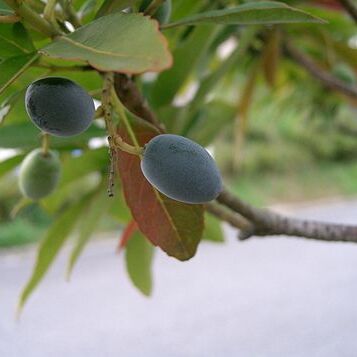Shrubs or trees, the pubescence of stellate hairs, the young branches usually pubescent, the older ones glabrate or nearly so. Leaves alternate, petiolate, stipulate, the stipules usually large, fugacious or infrequently persistent, the blade entire or 3-lobate, sometimes auriculate-appendaged at the base, the margins irregularly serrate, the basal serrations usually glandular, 3-to 7-palminerved. Inflorescences gynodioecious or hermaphrodite, usually terminal, infrequently axillary, large, paniculiform, the ultimate branchlets bearing clustered cymes. Flowers either hermaphrodite or pistillate, actinomorphous, pedicellate, 4-to 5-merous; calyx valvate, the sepals sometimes minutely appendiculate at the apex, usually pubescent without, glabrate within; petals 4-5 in the hermaphrodite flowers, absent in the pistillate ones, free, valvate, shorter than the sepals, gland-less; stamens 12-40 in the hermaphrodite flowers, staminodial or absent in the pistillate ones, inserted on an enlarged and very short gonophore, the filaments free; anthers 2-thecate, introrse, more or less medifixus, versatile, longitudinally dehiscent; ovary superior, sessile on the gonophore or borne on a gynophore, later-ally compressed, ciliate along the margins and with shorter pubescence on the faces, 2-celled (falsely 4-celled at the base), the cells 2-ovulate; style filiform, bifid, the stigma-lobes spreading, simple or slightly 9-to 3-lobulate. Fruit cap-sular, sessile or stipitate upon the accrescent gynophore, laterally compressed and bearing along the margins 2 rows of long plumose bristles, the faces pubescent or glabrate, indehiscent, 2-loculate, (l-)2(-3))-seeded; seeds small, pendulous, com-pressed-ovoid or compressed-pyriform; albumen carnose; embryo straight; coty-ledons plane, foliaceous.
More
Trees or rarely shrubs. Leaves alternate or spirally arranged; stipules linear or rarely leaflike, caducous, rarely persistent; petiole usually long and swollen at both ends; leaf blade margin serrate or entire, pinnately veined. Inflorescence axillary, racemose. Flowers bisexual, 4-or 5-merous. Sepals 4 or 5, valvate, abaxially usually pubescent. Petals 4 or 5, white, free, margin laciniate, rarely entire or lobed. Stamens 8 to numerous; filaments short; anthers 2-celled, dehiscing from apical slits, with awn or hairs at tip. Disk usually glandularly 5-10-lobed, rarely circular. Ovary superior, 2-5(-7)-loculed; ovules 2-12 per locule; style linear or subulate. Fruit a drupe, 1(or 5)-loculed; endocarp hard, bony, surface usually lacunose. Seeds usually 1 per locule, with fleshy endosperm; cotyledons thin; embryo straight or curved.
Sepals and petals 4-5, inserted around disk. Stamens ∞; anthers linear, ± awned, opening by terminal pores or slits. Ovary 2-5-celled; ovules 2 to several per cell, pend. Style subulate, stigma simple. Fr. a drupe, endocarp stony, often rugose, 2-5-(1)-celled. Seeds solitary in each cell. Trees. Some 90 mainly tropical spp., ours endemic.

